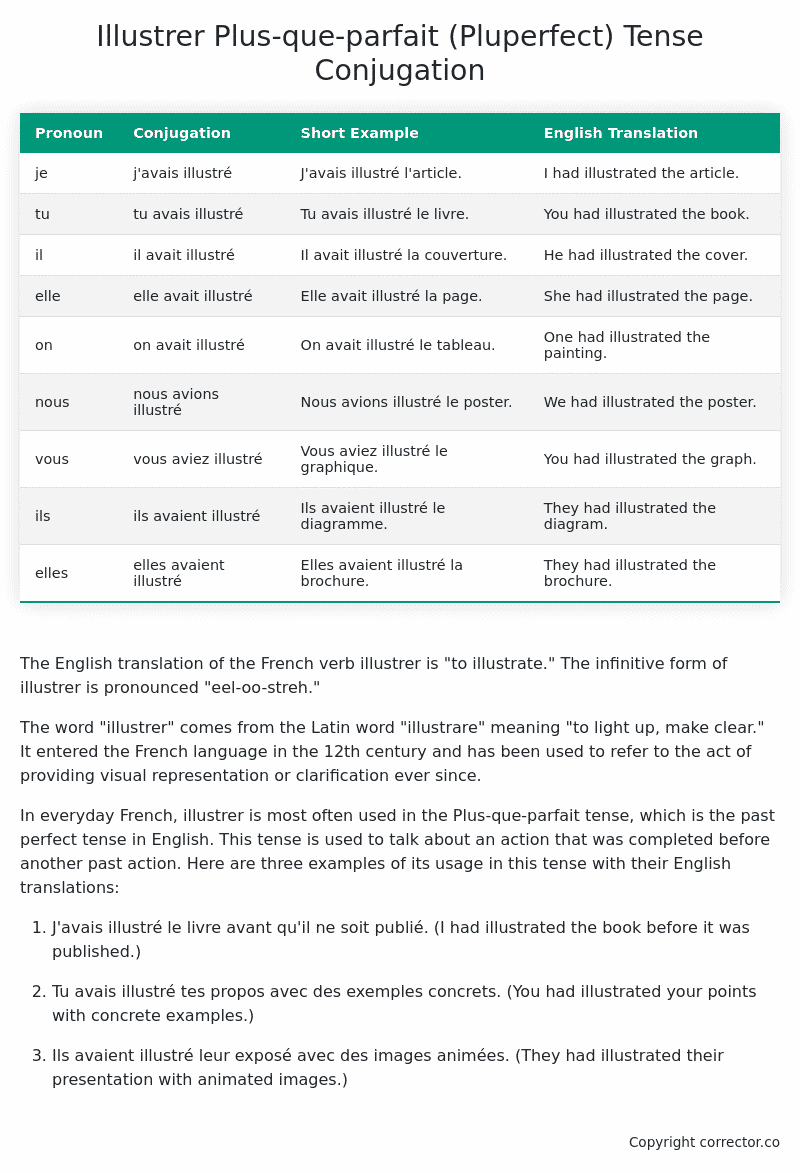Plus-que-parfait (Pluperfect) Tense Conjugation of the French Verb illustrer
Introduction to the verb illustrer
The English translation of the French verb illustrer is “to illustrate.” The infinitive form of illustrer is pronounced “eel-oo-streh.”
The word “illustrer” comes from the Latin word “illustrare” meaning “to light up, make clear.” It entered the French language in the 12th century and has been used to refer to the act of providing visual representation or clarification ever since.
In everyday French, illustrer is most often used in the Plus-que-parfait tense, which is the past perfect tense in English. This tense is used to talk about an action that was completed before another past action. Here are three examples of its usage in this tense with their English translations:
-
J’avais illustré le livre avant qu’il ne soit publié. (I had illustrated the book before it was published.)
-
Tu avais illustré tes propos avec des exemples concrets. (You had illustrated your points with concrete examples.)
-
Ils avaient illustré leur exposé avec des images animées. (They had illustrated their presentation with animated images.)
Table of the Plus-que-parfait (Pluperfect) Tense Conjugation of illustrer
| Pronoun | Conjugation | Short Example | English Translation |
|---|---|---|---|
| je | j’avais illustré | J’avais illustré l’article. | I had illustrated the article. |
| tu | tu avais illustré | Tu avais illustré le livre. | You had illustrated the book. |
| il | il avait illustré | Il avait illustré la couverture. | He had illustrated the cover. |
| elle | elle avait illustré | Elle avait illustré la page. | She had illustrated the page. |
| on | on avait illustré | On avait illustré le tableau. | One had illustrated the painting. |
| nous | nous avions illustré | Nous avions illustré le poster. | We had illustrated the poster. |
| vous | vous aviez illustré | Vous aviez illustré le graphique. | You had illustrated the graph. |
| ils | ils avaient illustré | Ils avaient illustré le diagramme. | They had illustrated the diagram. |
| elles | elles avaient illustré | Elles avaient illustré la brochure. | They had illustrated the brochure. |
Other Conjugations for Illustrer.
Le Present (Present Tense) Conjugation of the French Verb illustrer
Imparfait (Imperfect) Tense Conjugation of the French Verb illustrer
Passé Simple (Simple Past) Tense Conjugation of the French Verb illustrer
Passé Composé (Present Perfect) Tense Conjugation of the French Verb illustrer
Futur Simple (Simple Future) Tense Conjugation of the French Verb illustrer
Futur Proche (Near Future) Tense Conjugation of the French Verb illustrer
Plus-que-parfait (Pluperfect) Tense Conjugation of the French Verb illustrer (this article)
Passé Antérieur (Past Anterior) Tense Conjugation of the French Verb illustrer
Futur Antérieur (Future Anterior) Tense Conjugation of the French Verb illustrer
Subjonctif Présent (Subjunctive Present) Tense Conjugation of the French Verb illustrer
Subjonctif Passé (Subjunctive Past) Tense Conjugation of the French Verb illustrer
Subjonctif Imparfait (Subjunctive Imperfect) Tense Conjugation of the French Verb illustrer
Subjonctif Plus-que-parfait (Subjunctive Pluperfect) Tense Conjugation of the French Verb illustrer
Conditionnel Présent (Conditional Present) Tense Conjugation of the French Verb illustrer
Conditionnel Passé (Conditional Past) Tense Conjugation of the French Verb illustrer
L’impératif Présent (Imperative Present) Tense Conjugation of the French Verb illustrer
L’infinitif Présent (Infinitive Present) Tense Conjugation of the French Verb illustrer
Struggling with French verbs or the language in general? Why not use our free French Grammar Checker – no registration required!
Get a FREE Download Study Sheet of this Conjugation 🔥
Simply right click the image below, click “save image” and get your free reference for the illustrer Plus-que-parfait tense conjugation!

Illustrer – About the French Plus-que-parfait (Pluperfect) Tense
Tense Formation
Common everyday usage patterns
Sequencing of past events
Background information
Hypothetical or reported speech
Interactions with other tenses
Summary
I hope you enjoyed this article on the verb illustrer. Still in a learning mood? Check out another TOTALLY random French verb conjugation!


